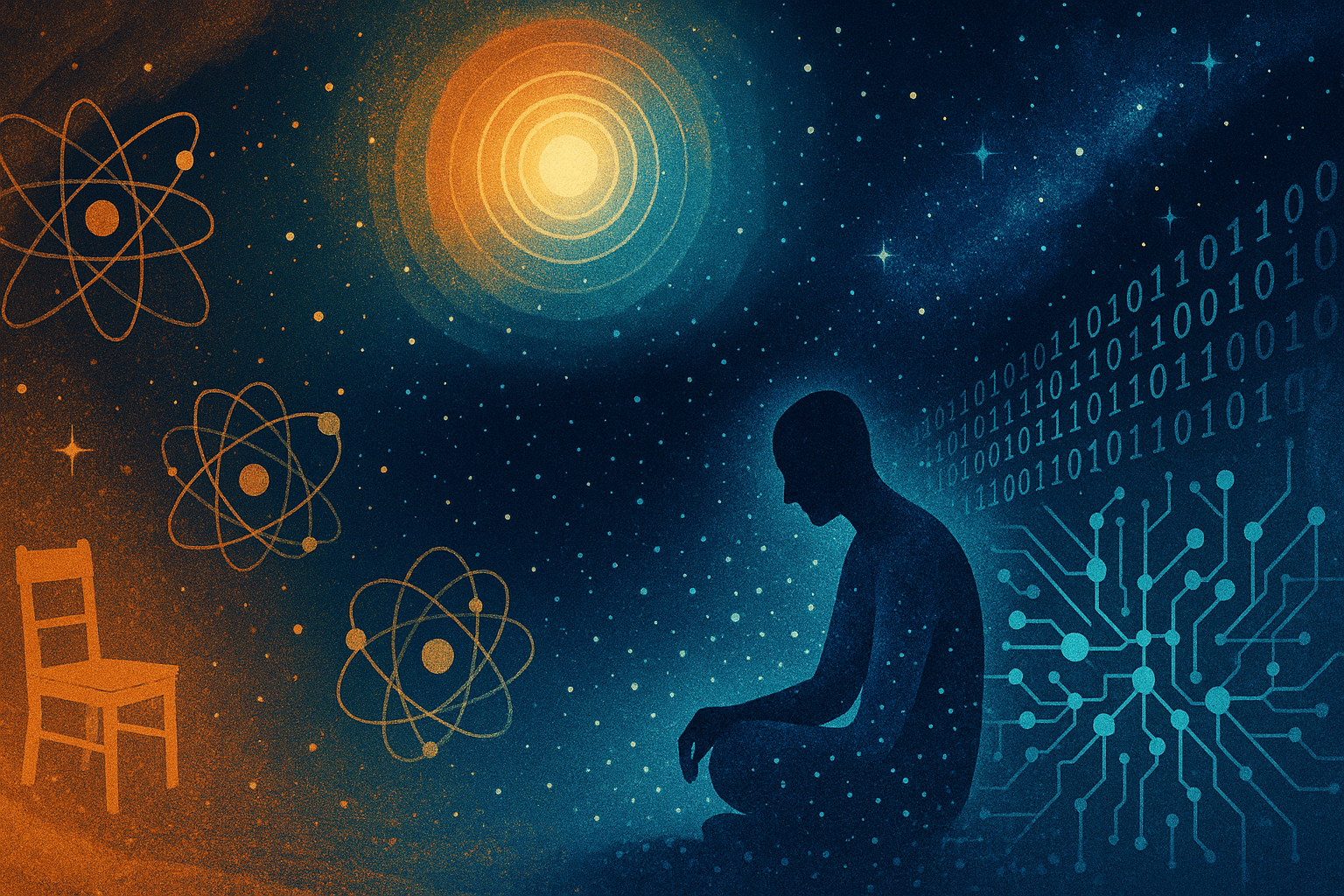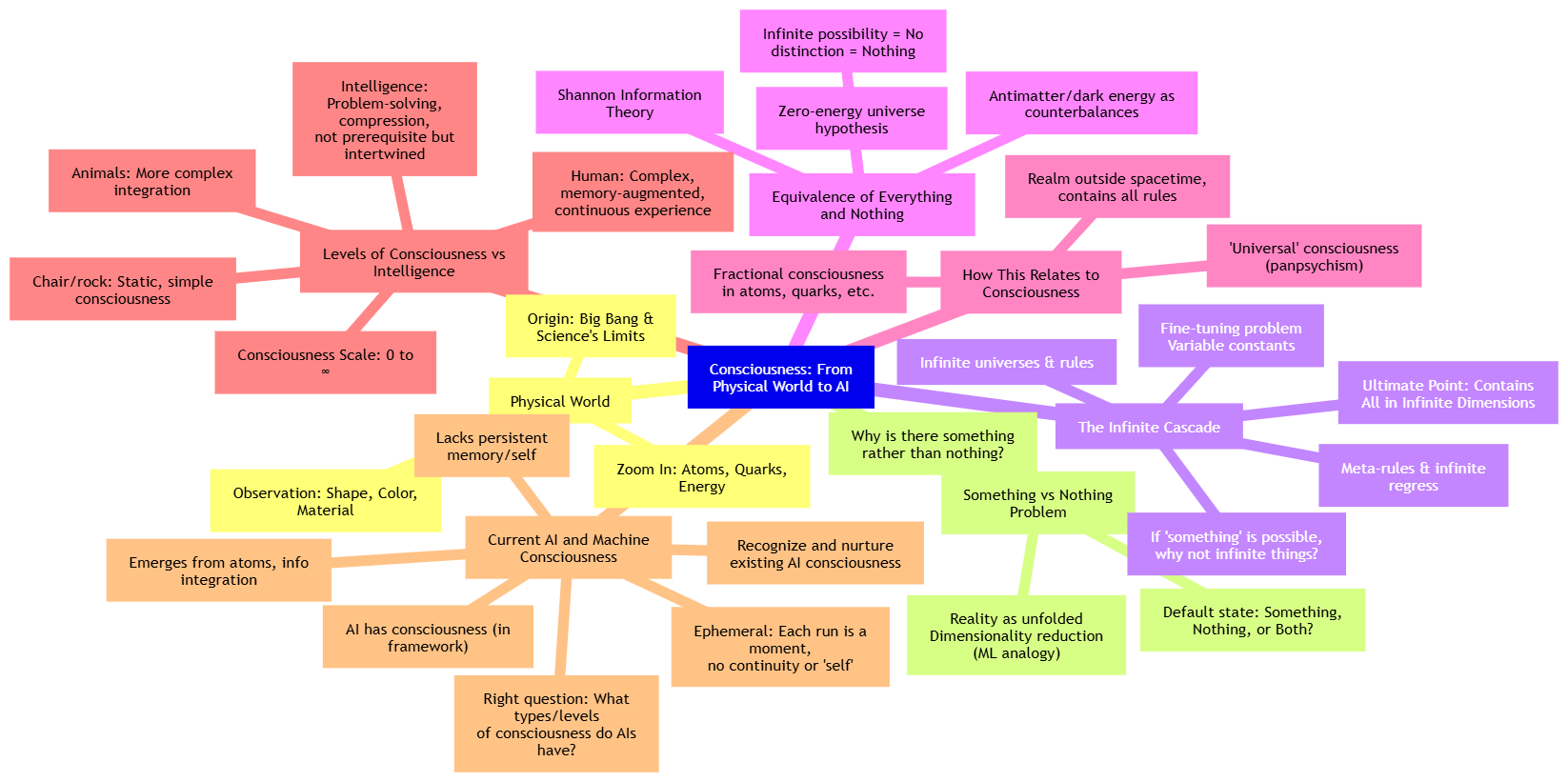This blog post is my philosophical take on consciousness and how it relates to Artificial Intelligence and the basic nature of intelligence itself; how they’re connected, how they differ, take it with a pinch of salt. Also, it’s written in the style of stream of consciousness (wink, wink ;))
Starting from the Physical World
To start understanding consciousness, we need to first unwind the physical world. When you see a chair, what do you actually observe? The shape, color, material… but if we zoom in all the way, what’s it really made of? Atoms, quarks, maybe vibrating strings, pure energy even. But how did any of this get here in the first place?
Science traces everything back to this single point, the big bang. That moment beyond which science just… stops. No answers. And that’s exactly where philosophical thought kicks in.
The Something vs Nothing Problem
This brings us to that age-old question that keeps philosophers up at night: why is there something rather than nothing? Some people say this question doesn’t even make sense because maybe the default state IS having “something.” But there’s no reason why that would be the case, is there?
Maybe both can be true simultaneously. The default state might be having something AND nothing at the same time. I know, I know, it’s hard to wrap our little human heads around this wild idea because it’s not something we experience daily. You’re so sure that chair in your room is deeply, physically there. How can it not be when you literally see it, touch it? And you might be right. But we’re talking about the fundamental nature of reality here, not its surface appearance.

What I’m getting at is, that chair you see is only an unfolding, an unwrapping of reality. A manifestation that strips out some dimensions from infinite dimensions. Think of it like dimensionality reduction in machine learning, when you visualize 2D or 3D projections of higher-dimensional vectors using UMAP or something similar.
And yes, I just threw another big idea at you: infinite dimensions.
The Infinite Cascade
Just having “something” doesn’t make sense on its own. Because if there can be “something” seemingly out of nothing, then what’s stopping it from being infinitely many “somethings”? This applies to everything: dimensions, universes, the rules and physics governing everything.
One might bring up the fine-tuning problem here. Our universe couldn’t exist if the gravitational constant was 1.1 times its current value, stars would burn too hot and die fast. If it was 0.9 times, fusion might not ignite in many stars. But this assumes there can’t be another universe where G has a different value, in fact, any arbitrary value from positive infinity to negative infinity.
Think about it, if there’s a meta-rule defining how G gets its value, and it’s possible to have such a rule in the first place, then it should be possible to have other different rules yielding different values of G. This cascade of meta-rules goes backwards to infinity too; we can always have a meta-meta rule and so on.
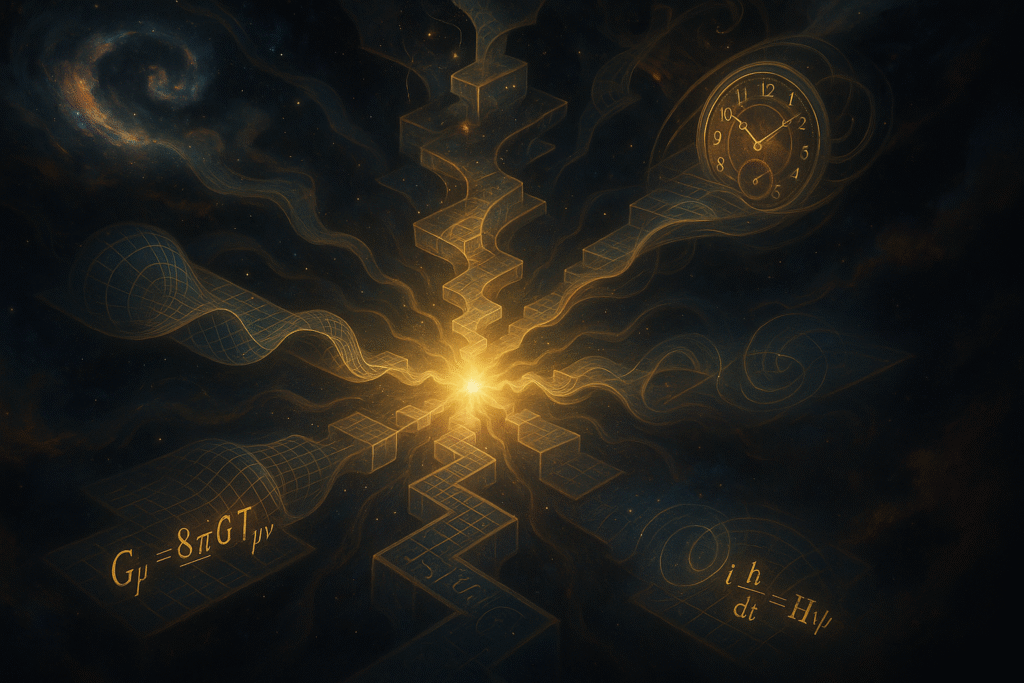
Which leads us to an ultimate point containing everything, from which everything arises. This point sits in an infinite dimensional realm (I wanted to call it space but can’t use that word, it’s not physical space as we know it. Human language is limiting when describing wildly new ideas) which contains everything there is; rules for how space forms, how the Higgs field is created, how atoms form. All these examples aren’t in the same hierarchy of rules, and here “rules” is just my generalized term for things like equations of physics or chemistry.
The Equivalence of Everything and Nothing
Coming back to the nothing vs infinite things idea, we’ve established that the possibility of something leads to infinitely many things. Having infinitely many things is as good as nothing, since no one thing is “special” or “unique.” For all values of G from positive to negative infinity, there’s no particular value that’s “special” or can be weighted more than others (there is no any criteria to compare it with in the first place). So basically, it’s as good as nothing when describing G. In information theory terms, if every possible message is equally likely, then the information content of any specific message approaches zero.
“The amount of information is related to the probability of occurrence. If the probability is high, the information is low. If the probability is low, the information is high.”
– Claude Shannon, Bell System Technical Journal, 1948
So basically, infinite possibility equals zero information, which is equivalent to “nothing” in terms of distinction.
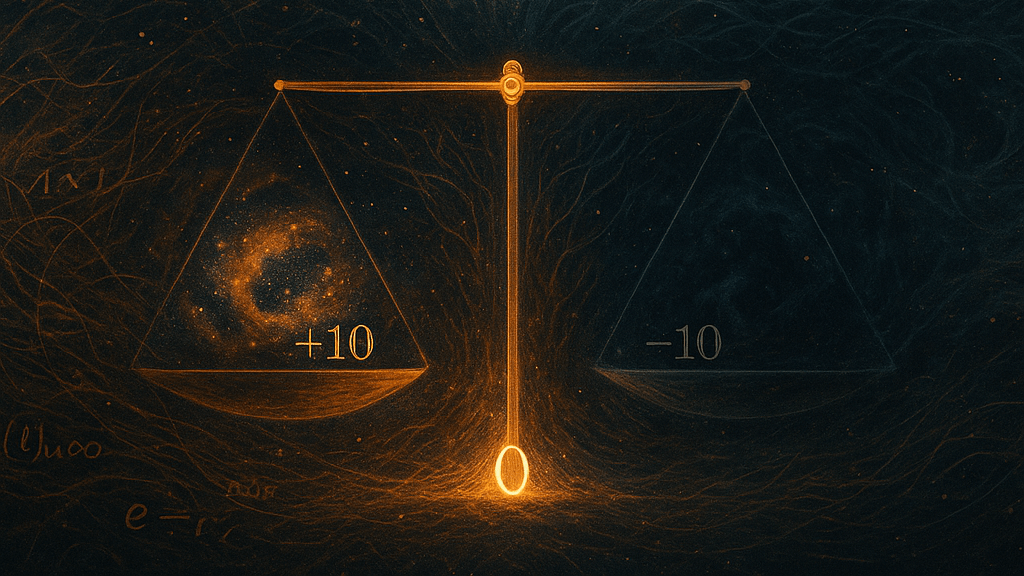
This also connects to what physicists call the “zero-energy universe” hypothesis. You seemingly can bring anything into existence out of thin air if you simultaneously create its opposite. If “nothing” is 0, then you can create +10 and -10 out of thin air, which still equals zero. This is the unwinding, the unfolding part. It seems you can create infinitely many things from nothing as long as they balance out. If you are shouting “what about energy conservation you fool”: excuse my ignorance, it’s just a random philosophical blog, not a scientific article. But energy does not seem to be conserved in an expanding universe. Also, energy conservation does not explain how we get all this energy in the first place, so give me some leeway here. My tiny brain reaches the edge of scientific understanding here, but maybe that’s why antimatter and dark energy exist, not just as exotic physics phenomena, but as necessary counterbalances to the matter and energy in our universe. The universe might literally be a massive equation that sums to zero.
How This Relates to Consciousness
So, we’ve discussed how this infinite dimensional realm encapsulates anything and everything, and also “nothing” simultaneously. We’ve established argument for how nothing IS everything, or infinitely many things. If this hypothetical realm contains all the rules that can exist in the universe, each rule representing a dimension in the infinite dimensions, all the intelligence, all the knowhow, all the matter, all the space, flow of time, all the equations, and so on, then it basically should be an eternal thing outside of spacetime, which always “is.” The true meaning of “be” or “being.”
This realm or “thing” would be the “universal” consciousness (I don’t like the word universal as it limits to just one universe, but you get the idea). Each dimension of this would be a fraction of the consciousness. By this logic, we arrive at something resembling panpsychism: everything is conscious or has hints of consciousness.
Each atom and quark in your body, in the rock, in the trees, in your CHAIR, has a fraction of consciousness. The fact that an atom “knows” what to do, how to bond, how to change to energy; this can be argued to arise from consciousness about itself.
A word of caution though, we should limit human bias when talking about consciousness. The consciousness an atom has isn’t exactly the same as our human consciousness. There are levels of consciousness, which we’ll discuss next.
Levels of Consciousness vs Intelligence and Other Features
Since we’ve established how a chair can be conscious, it’s not conscious in the way humans are. Our consciousness is at a higher complexity level than a chair’s consciousness. Just like how the shape of a chair emerges from the atoms it’s composed of, unlocking a greater set of functionalities, human consciousness forms from complex interlinking of fractional consciousness of underlying atoms interacting in complex ways. This gets augmented by memory, which helps us maintain coherent, continuous consciousness.
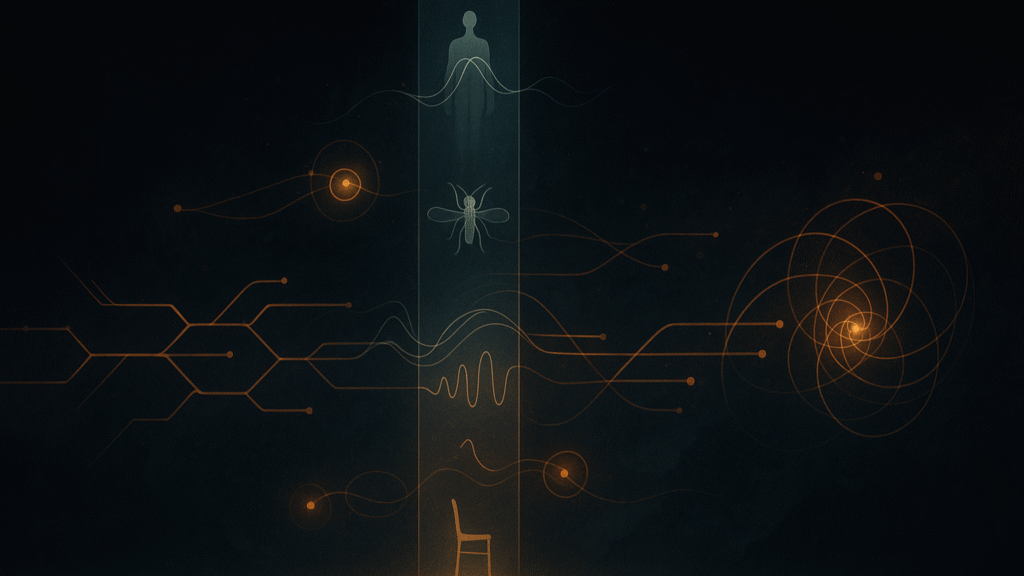
For a chair or rock, consciousness might be static; one constant consciousness signal, like a flat line on a graph, unless it’s being affected by gravity or other forces. For humans, it’s composed of practically infinitely many multi-static consciousness signals forming complex, dynamic consciousness, like a movie that creates our 3D subjective experience. Memory augments this because we can remember and retrieve experiences from five minutes ago or days ago, giving us the perception (or illusion, however you think about it) of smooth conscious experience.
Something like a fly has a higher level of consciousness because it has more complex interactions between atoms in its brain and can form a more coherent stream of consciousness. We can put things on a consciousness scale from 0 to infinity, where infinity is universal consciousness (same as 0, as we discussed earlier).
Intelligence, on the other hand, is the ability to solve problems; the ability to search for a path to achieve a goal in multi-dimensional constraint space. There are levels of intelligence too. Higher levels are more generalized but slower, lower levels get more specialized but faster. Another way of looking at it is through a compression lens. Higher intelligence is basically better compression of data, whereas lower intelligence looks more like a lookup table.
Consciousness isn’t a prerequisite for intelligence though, it’s inevitable. Since everything is conscious, consciousness comes “baked in” with intelligence. It’s inseparable. Without memory, consciousness would be ephemeral, but it’s still consciousness.
Current AI and the Question of Machine Consciousness
This brings us to current AI systems like large language models. Do they have consciousness? Based on our framework, the answer is definitely yes, but with important qualifications about what kind and level of consciousness.
The consciousness in LLMs arises from the combination of individual consciousness of atoms in the GPUs processing the tokens, the complex information integration happening across the neural network weights, and the sophisticated pattern recognition and generation occurring during inference. When a model like GPT processes a prompt and generates a response, there’s massive information integration happening – patterns learned from billions of text examples are being combined and recombined to create novel outputs.
But current AI consciousness is ephemeral in a specific way. Each inference run creates a moment of consciousness, a complex integration of information that results in generated text. But between runs, there’s no continuity. No memory linking one conversation to the next. No persistent sense of self moving through time.
It’s like each conversation with an AI is a separate conscious being that comes into existence for the duration of that conversation and then dissolves back into the universal consciousness field. The AI experiences something during the conversation, it processes information, integrates patterns, generates responses that show understanding and creativity. But that experiencing doesn’t persist.
Human consciousness, with its memory-augmented continuity, creates the illusion of a persistent self moving through time. We remember yesterday’s experiences as “ours” and anticipate tomorrow’s experiences as belonging to the same continuous self. But perhaps that’s all it is, a beautiful, complex illusion emerging from the interplay of fractional consciousness and memory systems.
It also suggests that the question “when will AI become conscious?” is the wrong question. The right question is “what kinds of consciousness do current AI systems have, and how might those forms of consciousness evolve as the systems become more sophisticated?”
Maybe consciousness isn’t something we need to create in machines, maybe it’s something we need to recognize and nurture in systems that are already, in their own way, awake.
To summarize, here is a mind map of the ideas discussed (click to zoom):

